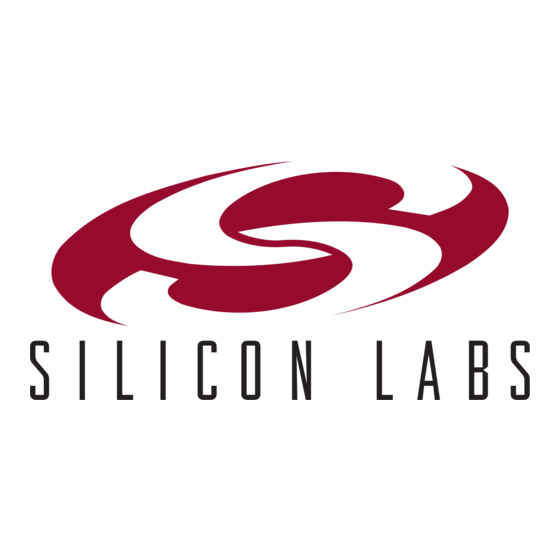Summary of Contents for Silicon Laboratories C8051F34 Series
- Page 1 EN : Th is Dat asheet is pr esent ed by t he m anuf act ur er . Please v isit our websit e f or pr icing and av ailabilit y at w w w.hest or e.hu.
-
Page 2: Kit Contents
CD-ROM 2. Hardware Setup Using a USB Debug Adapter The target board is connected to a PC running the Silicon Laboratories IDE via the USB Debug Adapter as shown in Figure 1. 1. Connect the USB Debug Adapter to the DEBUG connector on the target board with the 10-pin ribbon cable. -
Page 3: Software Setup
C8051F34x 3. Software Setup Simplicity Studio greatly reduces development time and complexity with Silicon Labs EFM32 and 8051 MCU products by providing a high-powered IDE, tools for hardware configuration, and links to helpful resources, all in one place. Once Simplicity Studio is installed, the application itself can be used to install additional software and documentation components to aid in the development and evaluation process. - Page 4 C8051F34x 3.1. Running Blinky Each project has its own source files, target configuration, SDK configuration, and build configurations such as the Debug and Release build configurations. The IDE can be used to manage multiple projects in a collection called a workspace.
- Page 5 C8051F34x 3.3. Legacy 8-bit IDE Note: Using the Simplicity Studio tools with the C8051F340 Development Kit is recommended. See section 3. "Software Setup‚" on page 2 for more information. Download the 8-bit software from the website (www.silabs.com/8bit-software) or use the provided installer on the CD-ROM to install the software tools for the C8051F34x devices.
- Page 6 C8051F34x information. 7. Once the form is complete, click the Submit button. An email will be sent to the provided email address with the license activation code. 8. Copy the License ID Code (LIC) from the email. 9. Paste the LIC into the New License ID Code (LIC) text box at the bottom of the License Management window in µVision4.
-
Page 7: Target Board
Jumper connection for pin 1.5 to capacitors (used when VREF is internally generated) Jumper connection for potentiometer source to VDD Jumper connection for potentiometer to pin 2.5 Serial Adapter target board power connector P2.0 RESET P2.1 RS232 SILICON LABORATORIES C8051F340-TB Figure 4. C8051F340 Target Board Rev. 0.3... - Page 8 C8051F34x 4.1. System Clock Sources The C8051F340 device installed on the target board features a calibrated programmable internal oscillator which is enabled as the system clock source on reset. After reset, the internal oscillator operates at a frequency of 1.5 MHz (±1.5%) by default but may be configured by software to operate at other frequencies.
- Page 9 C8051F34x 4.3. Universal Serial Bus (USB) Interface (J14) A Universal Serial Bus (USB) connector (P3) is provided to facilitate connections to the USB interface on the C8051F340. Table 2 shows the J14 pin definitions. Table 2. USB Connector Pin Descriptions Pin # Description VBUS...
- Page 10 C8051F34x 4.6. Target Board DEBUG Interface (J9) The DEBUG connector (J9) provides access to the DEBUG (C2) pins of the C8051F340. It is used to connect the Serial Adapter or the USB Debug Adapter to the target board for in-circuit debugging and Flash programming. Table 4 shows the DEBUG pin definitions.
- Page 11 Figure 5. C8051F340 Target Board Schematic (Page 1 of 2)
- Page 12 Figure 6. C8051F340 Target Board Schematic (Page 2 of 2)
-
Page 13: Document Change List
C8051F34x OCUMENT HANGE Revision 0.1 to Revision 0.2 Removed EC2 Serial Adapter from Kit Contents. Removed Section 2. Hardware Setup using an EC2 Serial Adapter. See RS232 Serial Adapter (EC2) User's Guide. Removed Section 8. EC2 Serial Adapter. See RS232 Serial Adapter (EC2) User's Guide. ... -
Page 14: Contact Information
Silicon Laboratories products are not designed, intended, or authorized for use in applications intended to support or sustain life, or for any other application in which the failure of the Silicon Laboratories product could create a situation where per- sonal injury or death may occur.



Need help?
Do you have a question about the C8051F34 Series and is the answer not in the manual?
Questions and answers